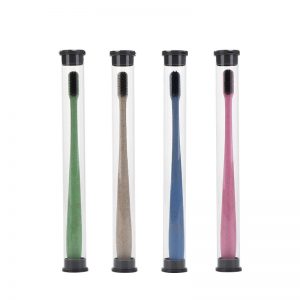More than 2,000 years ago, the ancients knew how to protect teeth. The “Historical Records of Cang Gong Zhuan” pointed out that the cause of cavities was “eating and not gargle”. People have the habit of gargle. There is a saying among the folks that “picking horses and looking for teeth, choosing husbands to see teeth”, to the effect that picking a horse depends on the teeth, and picking a son-in-law also depends on the teeth. It is common knowledge in social life that strong teeth are healthy.
In 3,500 BC, the Babylonians chose the fragrant fine-rooted branches to chew softly, shaped like bristles, for brushing their teeth, and the other end was sharpened to facilitate flossing. This method is similar to Li Shizhen in the Ming Dynasty mentioned in the “Compendium of Materia Medica” that “tender willow branches are cut into tooth branches, and the teeth are cleaned very well.”
In 3000 BC, the first tool used to clean the mouth was found in the tomb of the Sumerian Ur city state—the tooth stick.
In ancient Greece, people used animal ashes as tooth powder to clean their mouths.
In ancient Rome, people used charcoal, salt water, fine sand, and tree branches to clean their teeth.
Arabs took the branches from a tree called Arak, mashed the ends and made them into brushes, used to clean between teeth and brush their teeth to prevent tooth decay.
Starting in the Tang Dynasty, people used willow branches to make brushes and dipped them in medicine to wipe their teeth. Tang doctor Wang Tao described in “Waitai Miyao” that cohosh, angelica, agarwood, etc. were used as medicine, crushed into powder, and willow branches were bitten, and the medicine was applied to scrub the teeth. This is the embryonic form of early toothbrushes and toothpaste.
In the Song Dynasty, people advocated using willow branches to wipe their teeth twice a day in the morning and evening. Officially, there was the term toothbrush. Guo Yu said in his poem: “Nanzhou toothbrushes are worth a golden value on the first day of sending them to the toothbrushes.”
In the Yuan Dynasty, most people used willow branches as a toothbrush, and brushed their teeth with a toothbrush powder made from Chinese herbal medicine. Guo Jue’s sentence in “Jing Si Ji” “Short hairpins are cut into tortoiseshell light, and ice silk is embellished with silver bristle”, which shows that toothbrushes were quite popular in the Yuan Dynasty. At that time, toothbrush handles were not very long. The shape is like a tortoiseshell, and the bristles used for the bristles have been delicately processed to have the original shape of a modern toothbrush.
In the 16th century AD, the Chinese invented the first real toothbrush in history using Siberian mountain pig hair and bamboo or bone as a handle. People used bamboo as a handle and attached wild boar hair. Such toothbrushes are the ancestors of today’s toothbrushes.
Chinese pig hair toothbrushes spread to Europe at that time. Because pig hair was very rough, people switched to horse hair as a brush to increase flexibility. However, horse hair was too expensive and pig hair toothbrushes were used until around 1900.
At the same time, Europeans improved the toothbrush. They carved a sturdy brush rod from cow bones, drilled holes at the end, and fixed pig hair with filaments, making it an ancient toothbrush that is closest to modern toothbrushes.
The British cobbler William Addis first invented the toothbrush in a London prison in 1780. He grinds the bones into a thin rod, drills some small holes in it, and then inserts the bristles into the small holes in bunches and inserts them. Neatly trimmed, the world’s first toothbrush was born in prison. After leaving prison, Addis set up his own toothbrush factory, which was very successful. The first toothbrush invented by William Addis was made of Chinese Siberian pig hair.
In 1857, Vaznoz in the United States invented and applied for the first toothbrush patent in the North American market.
At the end of the 19th century, the Florence Manufacturing Company of Massachusetts used improved technology to mass produce cheap toothbrushes, which turned the United States from a toothbrush importer to a toothbrush manufacturer and began to participate in international market competition for toothbrush products.
The Germans invented a new type of U-shaped toothbrush at the beginning of the 20th century. The end bristles are fan-shaped and can clean the inside and outside of the teeth at the same time, which greatly improves the efficiency of brushing.
In the 1930s, Wallace HCarothers invented nylon in DuPont Laboratories. Nylon became a symbol of modernization. This invention changed the history of toothbrushes forever.
In 1938, DuPont of the United States used nylon yarn to replace pig hair and ponytail technology, and the first nylon toothbrush appeared, which increased the production efficiency of toothbrushes by hundreds of thousands of times and reduced the price of toothbrushes to a level acceptable to most people. .
In the 1940s, when the Second World War began, the U.S. government ordered soldiers to brush their teeth every day, forcing the most respected people in society to start the habit of brushing their teeth.
At the same time, the American advertising industry vigorously promoted toothbrush and toothpaste sales services. Movies and TV stars became the spokespersons of toothbrushes and toothpaste. Military men and celebrities took the lead in brushing teeth. Toothbrush and toothpaste became a social fashion at the time and made the United States a developed toothbrush and toothpaste industry. , It has also led to the popularization of oral hygiene in the western world and the vigorous development of tooth brushing habits.
In 1950, dentist Dr. Robert Hasen invented the world’s first nylon soft toothbrush, which was the embryonic form of a health toothbrush.








